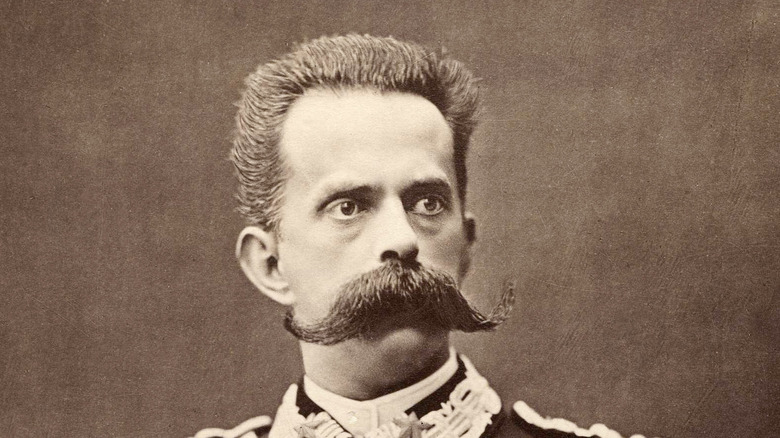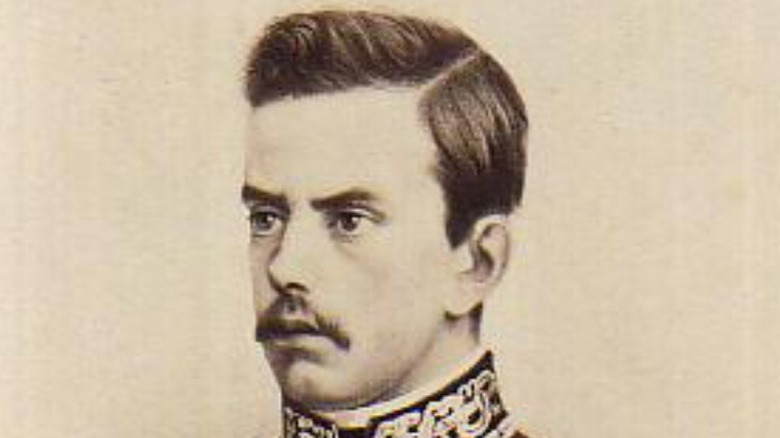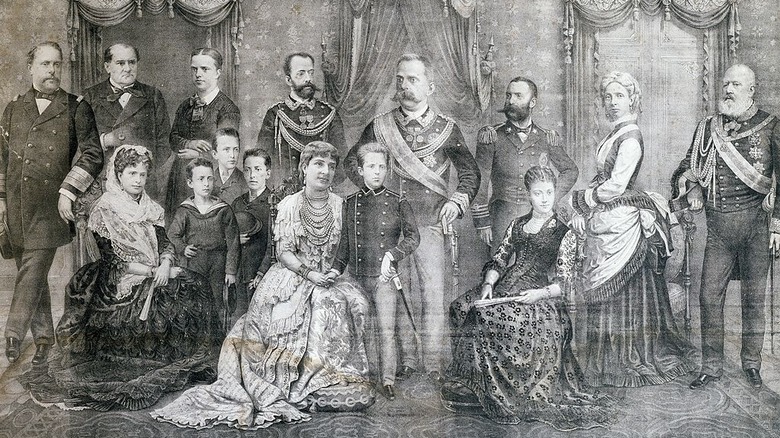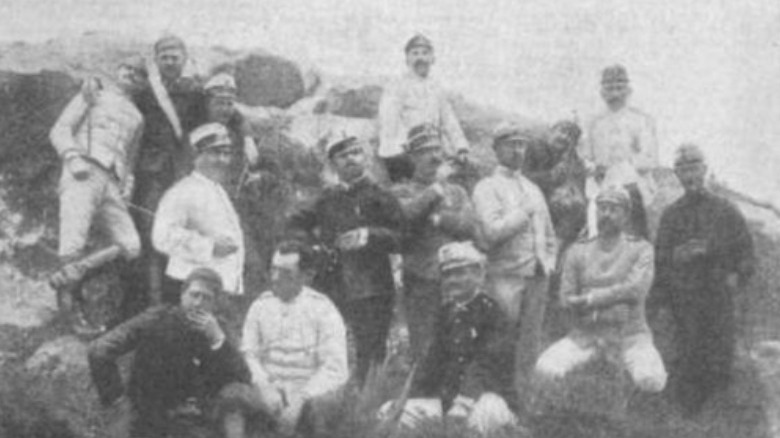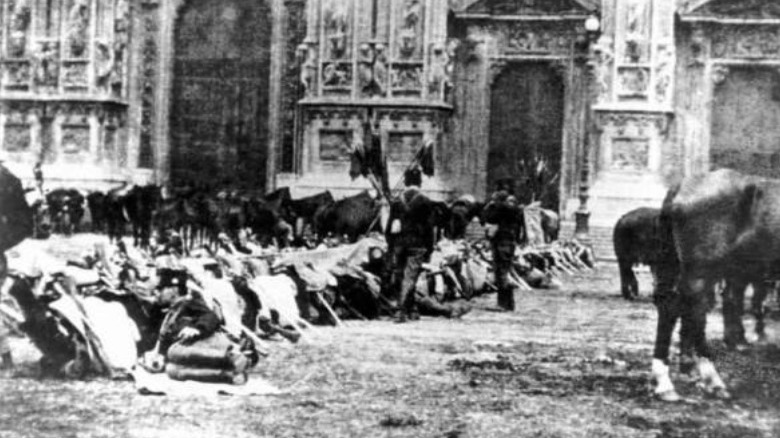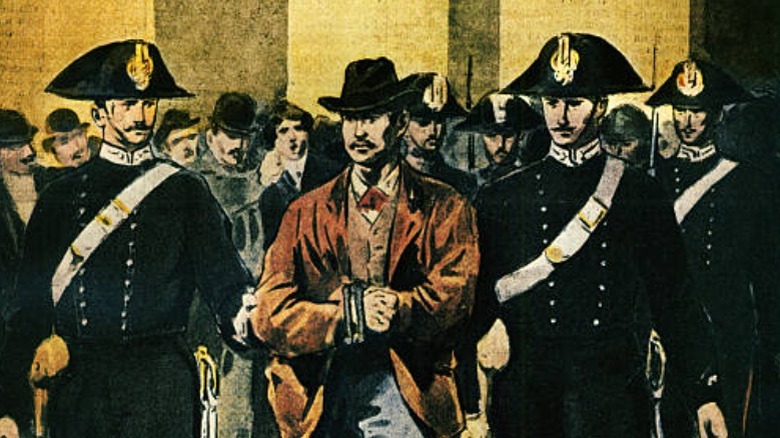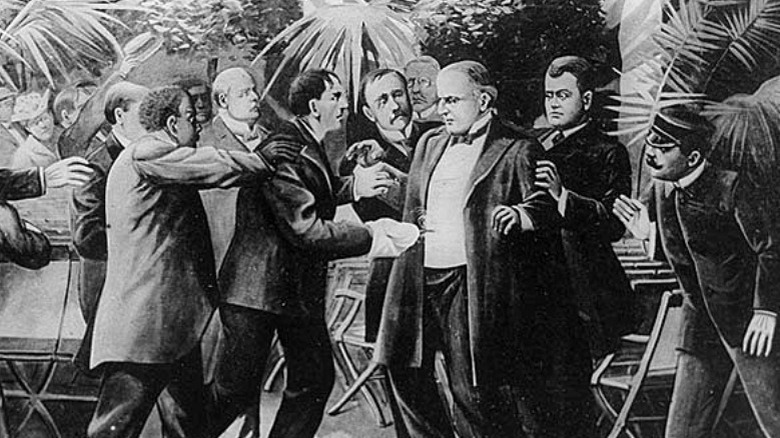This Is The Assassination Of King Umberto Of Italy Explained
On July 28, 1900, King Umberto of Italy stumbled upon his doppelgänger while dining in a restaurant. Not only was the restaurant owner the spitting image of the King of Italy, but the doppelgänger was also named Umberto, born on the same day in the same town as the king, and was also married to a woman named Margherita.
King Umberto arranged to meet with Umberto the restaurant owner the following day, but the doppelgänger was reportedly killed the following morning in "unexplained circumstances," according to Ripley's. Stranger still, King Umberto was assassinated that very afternoon.
The connection between the two men remains unknown, but the assassination of King Umberto is a little more straightforward. He not only sacrificed thousands of people's lives in his pursuit of military conquest, but he also commended those who butchered on his behalf. Ultimately, this would be the domino effect that results in his assassination — and even then, the dominos don't stop falling. The assassination of King Umberto is said to have "destroyed the symbol of the state and the most revered figure for the military, the king," (per "The First World War"). This is the assassination of King Umberto of Italy explained.
Who was Umberto I?
King Umberto I was born on March 14, 1844, to Archduchess Adelaide of Austria and King of Sardinia Victor Emmanuel II in the Kingdom of Sardinia — the predecessor of the Kingdom of Italy. Born a duke of Savoy, the education Umberto received before he ascended the throne was a "totally military education," according to Encyclopedia Britannica. He fought in the Second and Third Italian Wars of Independence, and in 1866 went on to fight in the war against Austria and in Custoza. His competence on the battlefield won him public support.
But the all-encompassing military education wasn't necessarily for Umberto's benefit. According to "Italy and Its Monarchy" by Denis Mack Smith, "the Savoy dynasty was traditionally so distrustful of each new generation" that heirs to the throne were kept from learning anything about ruling or public life, and "given no encouragement to exercise personal initiative or understand the subtleties of constitutional government."
In 1868, Umberto married Margherita Teresa Giovanna, princess of Savoy, and their son — the future Victor Emmanuel III — was born the following year. In 1878, Umberto ascended the throne to become Umberto I, King of Italy, rather than Umberto IV of Savoy, because the modern Italian state was founded in 1861, per the Office of the Historian. Umberto's nickname would become "Il Buono," meaning "the Good," writes The Famous People. For many people, however, his reign — defined by military conquest — would be anything but good.
Assassination attempt of Umberto
Umberto I became the King of Italy on January 9, 1878, and within the first year of his rule he'd already survived one assassination attempt. On November 17, 1878, Umberto was attacked by Giovanni Passannante while driving through Naples with his family and Italian Prime Minister Benedetto Cairoli. According to "Royal Murders" by Dulcie M. Ashdown, Passannante jumped into the carriage and stabbed Umberto in the shoulder with a dagger, but Cairoli got in the way of the second strike, taking the dagger in his own thigh instead.
Passannante was described as an anarchist and sentenced to death, but Umberto commuted his sentence to life imprisonment. According to the International Herald Tribune, Passannante's entire family was also imprisoned as punishment, although his brother was able to escape.
Passannante was jailed on the island of Elba and held in solitary confinement for over 30 years, which understandably, per Nautilus, resulted in an incredibly "negative psychological outcome." In 1910, he was transferred to a psychiatric hospital and reportedly died "shortly after." But his journey didn't end there. His head and brain were removed to be studied as part of the eugenics movement, which believed that criminality could be physically described. After being studied, the skull and brain were put on display at a criminology museum in Rome until 2007.
Umberto's colonial ambitions
As European countries scrambled to colonize the African continent, Italy made its first mark when it declared Eritrea to be an Italian colony in 1882. By 1889, Italy's colonization of Eritrea was recognized by Ethiopia through the Treaty of Wuchale. According to The Collector, Somalia was also colonized by Ethiopia in 1889.
In the Italian version of the Treaty of Wuchale, Article 17 claimed that Ethiopia "must" delegate its foreign affairs to Italy. But in the Amharic translation, it read that Ethiopia "could" delegate if they so chose to, but weren't forced to do so. After Ethiopia's Emperor Menilek II realized that he couldn't establish his own relationships with European countries, he denounced the treaty.
In response, Italy invaded and sought to colonize Ethiopia as well. But after Ethiopia defeated Italy at the Battle of Adwa in March 1896, per The Conversation, Italy was forced to sign the Peace Treaty of Addis Ababa on December 26, 1896.
According to "The Making of Strategy," edited by Williamson Murray, MacGregor Knox, and Alvin H. Bernstein, the money the Italian government poured into the attempted military conquest of Ethiopia had devastating domestic consequences for the people of Italy. Between 1888 and 1896, Italy experienced a severe depression, but "Umberto refused to reduce military expenditure." Meanwhile, the Italian army lost over 9,000 men in Italy, including Eritrean soldiers.
The Bava Beccaris massacre
In the years after the depression in Italy ended, most of the country was in a state of famine. In Milan in May 1898, people came together to protest rising food prices, and a large-scale strike was organized on May 5 as part of the protest, Charles Stephenson writes in "A Box of Sand."
After police killed several demonstrators, "a state of siege" was declared in Lombardy and General Fiorenzo Bava Beccaris was sent to the region. Up to 45,000 soldiers were also mobilized.
On May 7, 60,000 Milanese people went on strike, emboldened by the police killings of demonstrators from the previous two days. As protestors erected barricades in the Piazza del Duomo, Bava Beccaris was determined to regain control, and gave his men permission to use cannon fire against the protestors. History Extra writes that although the exact number of casualties is unknown, it's believed that between 118 and 400 people were killed by soldiers during the massacre, with up to 1,000 wounded, per Libcom. 1,500 Milanese were also given prison terms.
Umberto considered the massacre a success and awarded Bava Beccaris the Great Cross of the Order of Savoy, which decimated his already-waning public support. Meanwhile, in the United States, an Italian immigrant anarchist named Gaetano Bresci learned of the massacre, with some reports saying that his sister was one of its casualties, per "Avoiding the Terrorist Trap" by Thomas David Parker.
Umberto's assassination
After learning of the massacre, Gaetano Bresci decided to travel back to Italy and exact revenge by assassinating the king. According to Crimethinc, Bresci left the United States in May 1900, and arrived carrying "$200, a camera, and a five-shot pistol." After practicing his shot in the city of Prato, Bresci traveled to the countryside near Milan where Umberto was vacationing.
On July 29, "arriving to scattered applause," according to Libcom, Umberto attended an athletic competition and distributed prizes during the award ceremony afterwards. As he returned to his carriage after giving the athletes their prizes, Bresci came out from the crowd and shot Umberto four times as the king was sitting down in the carriage.
Umberto died immediately, having been hit three times in the chest, while Bresci allowed the Carabinieri, the Italian paramilitary police, to arrest him. He is also said to have stated, "I have not shot Umberto. I have killed a king, I have killed a principle."
Bresci was put on trial, found guilty of assassinating a king, and sentenced to life imprisonment. Because capital punishment in Italy was banned, Bresci became the first person to kill a European king "without toppling his regime" and not be executed, per NCR. However, Bresci was found dead less than a year into his life sentence on the island prison of Santo Stefano "in extremely suspicious circumstances."
Inspiring Leon F. Czolgosz
Bresci's assassination of King Umberto had a ripple effect as far as the United States. According to PBS, Leon F. Czolgosz, an anarchist living outside Canton, Ohio, was fascinated with the assassination and spent weeks learning the details of what Bresci had done.
On September 6, 1901, as President William McKinley toured the Pan-American Exposition in Buffalo, New York, Czolgosz pushed through the crowd and shot the president twice. After shooting McKinley, Czolgosz reportedly stated "I shot the president because he was the enemy of the people, the good working people," and "I killed President McKinley because I done my duty. I didn't believe one man should have so much service and another man should have none," per Crime, History & Societies. McKinley died eight days later from an infection, and Czolgosz was sentenced to death and executed after a two-day trial.
According to "Witnessing Their Faith" by Jay Alan Sekulow, the assassination may have directly led policymakers to "address seriously a change in qualifications for naturalization." This resulted in the passage of the Naturalization Act of June 29, 1906, which required applicants for naturalization to take an oath to be patriotic to the United States "against all enemies, foreign and domestic, and bear true faith and allegiance to the same."
